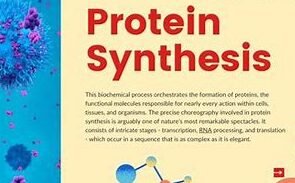Protein synthesis is a fundamental biological process that involves the creation of proteins, which are essential for the structure, function, and regulation of the body’s tissues and organs

1. The Central Dogma of Molecular Biology
- DNA to RNA to Protein: The central dogma of molecular biology describes the flow of genetic information from DNA to RNA to protein. This process involves two main steps: transcription and translation.
2. Transcription
- Location: Transcription takes place in the cell nucleus.
- Process: During transcription, a segment of DNA is used as a template to synthesize a complementary strand of messenger RNA (mRNA). The enzyme RNA polymerase plays a key role in this process.
- mRNA: The newly formed mRNA strand carries the genetic information from the DNA to the ribosome, where protein synthesis occurs.
3. Translation
- Location: Translation occurs in the ribosome, which can be found in the cytoplasm or attached to the endoplasmic reticulum.
- Process: During translation, the mRNA sequence is decoded to assemble a specific sequence of amino acids, forming a polypeptide chain (protein).
- Key Players:
- mRNA: Carries the genetic code from the nucleus to the ribosome.
- Ribosome: The molecular machine that reads the mRNA and facilitates the assembly of the protein.
- Transfer RNA (tRNA): Brings the appropriate amino acids to the ribosome based on the codons in the mRNA sequence.
- Codons: Three nucleotide sequences on the mRNA that specify particular amino acids.
4. Steps of Translation
- Initiation: The ribosome binds to the mRNA at the start codon (AUG), which signals the beginning of the protein-coding sequence.
- Elongation: The ribosome moves along the mRNA, reading codons and adding the corresponding amino acids to the growing polypeptide chain. Each tRNA molecule carries a specific amino acid and matches with its complementary codon on the mRNA.
- Termination: When the ribosome reaches a stop codon (UAA, UAG, or UGA), the translation process ends, and the newly synthesized polypeptide is released.
5. Protein Folding and Modification
- Folding: After translation, the polypeptide chain folds into its unique three-dimensional structure, which is essential for its function.
- Post-Translational Modifications: Proteins may undergo further modifications, such as phosphorylation, glycosylation, or cleavage, to become fully functional.
Importance of Protein Synthesis
Protein synthesis is crucial for maintaining cellular functions, supporting growth and development, and responding to environmental changes. Defects in protein synthesis can lead to various genetic disorders and diseases.
Understanding the science of protein synthesis provides insights into the molecular mechanisms that drive life and offers potential therapeutic targets for treating genetic and metabolic disorders.
